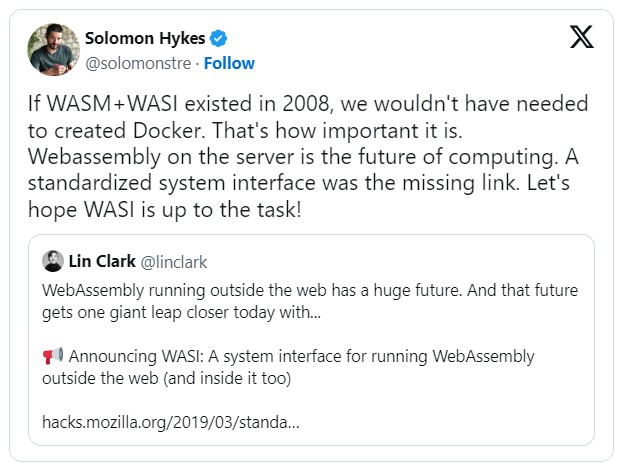
Throughout history, many technologies were created with a specific purpose in mind, only for their true potential to be realized later. Take the web, initially designed to exchange physics papers, which has evolved into a cornerstone of modern life. Or JavaScript, originally dismissed as a simple scripting tool for adding interactivity to web pages, now the world’s most widely used programming language. Today, WebAssembly (WASM) finds itself on a similar trajectory, expanding far beyond the intentions of its creators.
Initially built for use in web browsers, WebAssembly has already demonstrated its transformative impact on web development, as we’ve discussed in previous articles. However, its potential doesn’t stop at the browser. One of the most exciting frontiers for WASM is the cloud, where it’s quickly emerging as a game-changer for serverless computing. As WebAssembly continues to grow in popularity, it’s clear that it’s poised to become a foundational platform for running serverless functions in the cloud.
The road to WebAssembly
Before diving in, it’s worth reflecting on what set WebAssembly apart from earlier attempts to run non-traditional languages in the browser. Historically, there were several efforts to achieve this, but most fell short:
- Java Applets (deprecated in 2007)
- VBScript (a short-lived attempt by Microsoft, limited to its own browsers)
- Adobe Flash and Microsoft Silverlight (both came and went)
So, what makes WebAssembly so unique that it not only gained rapid adoption across all modern browsers but also expanded far beyond the web?
The first reason lies in its design philosophy. Mozilla, the driving force behind WebAssembly, collaborated with Google, Microsoft, Apple, and others, committing to build it under the W3C standards umbrella from the very beginning.
The second reason is WebAssembly’s innovative approach. Rather than supporting a single language, it introduced a binary format that existing programming languages could compile to. This fundamental difference is the cornerstone of its success.

Although the original post dates back to 2019 and reflected on past developments, the years that followed have only validated its insights. Today, WebAssembly has firmly established itself beyond the web, and one of the areas where it shines is in Serverless Architectures.
In the following sections, we’ll take a closer look at this exciting synergy.
Why WebAssembly in cloud computing?
Why has WebAssembly gained traction in cloud computing, particularly in serverless environments? The answer lies in its lightweight, fast, and secure execution model.
Serverless functions, or Function-as-a-Service (FaaS), allow developers to run small units of code in response to events without worrying about the underlying infrastructure. These functions need to meet several critical requirements:
- Lightweight: They must start up and execute quickly, as they’re typically used for short, event-driven tasks.
- Isolated and Secure: Security is essential since functions from different users may share the same hardware.
- Cross-Platform: Functions should run seamlessly across diverse cloud environments with minimal modifications.
WebAssembly aligns perfectly with these needs, making it an excellent choice for serverless computing. Here’s why:
- Low Overhead: WASM modules are compact and optimized for fast startup, significantly reducing “cold start” latency—a common challenge in serverless architectures.
- Security and Isolation: WASM’s robust sandboxing model ensures modules are isolated and have restricted access to the underlying system, enhancing security in multi-tenant environments.
- Cross-Platform Compatibility: WASM’s ability to run the same code across different operating systems and hardware makes it highly portable, ideal for serverless workloads across cloud platforms.
With its combination of low latency, strong sandboxing, and cross-platform capabilities, WebAssembly is well-suited for handling the short-lived, event-driven tasks common in serverless applications. As a result, more cloud providers are beginning to adopt WASM into their serverless offerings.
How WebAssembly works beyond the web
While WebAssembly (WASM) is inherently powerful, it was originally designed for web use and lacked essential features for broader applications, such as file access, networking, and system calls. These limitations were addressed by WASI (WebAssembly System Interface).
WASI is a standardized API that enables WebAssembly modules to interact with the host environment’s system resources – such as file systems, networking, and clocks—in a secure, platform-independent manner. It was developed by the Bytecode Alliance, an open-source organization co-founded by Mozilla, Fastly, Intel, and others to advance secure, portable, and high-performance WebAssembly-based software.
By bridging these gaps, WASI brings WebAssembly closer to the capabilities of traditional binaries while maintaining its hallmark portability and security.
Key features of WASI:
- Platform Independence: WASI allows WASM applications to run across diverse environments without requiring modifications.
- Security by Default: Building on WASM’s sandboxing model, WASI ensures modules can only access system resources explicitly permitted by the runtime.
- Modular API: WASI offers core functionalities like file I/O, networking, and clock access in a modular structure. Applications use only the capabilities they need, enhancing both security and performance.
Through WASI, WebAssembly expands its scope, enabling robust and secure interaction with host systems while retaining its lightweight and portable nature.

Tooling
Programming languages and technologies alone aren’t enough to build real-world applications or functions. Frameworks play a critical role in filling the gaps by offering essential tools, abstractions, and integrations that simplify the development, deployment, and management of applications. The same holds true for leveraging WebAssembly (WASM) in serverless functions.
To effectively develop serverless functions using WASM, several frameworks have emerged. Among them, two stand out as leading options:
These frameworks are specifically designed to harness WASM’s strengths in serverless environments. They provide the necessary tools, scalability, and security to efficiently develop and run event-driven, cloud-native applications.
Fermyon Spin
Fermyon Spin is recognized as one of the leading frameworks for building and deploying serverless applications powered by WebAssembly (WASM).
Key Strengths
- Ease of Use: Spin provides developer-friendly tools and a straightforward CLI, simplifying the process of building serverless functions without requiring extensive setup or infrastructure management.
- High Performance for Stateless Functions: Designed for stateless serverless functions, Spin leverages WASM’s fast execution times, making it ideal for use cases such as APIs, data processing, and event-driven microservices.
- Active Community and Support: Backed by an engaged community and a dedicated team, Fermyon Spin continues to evolve to address emerging WASM serverless use cases, making it a reliable choice for production environments.
Suborbital Atmo
Suborbital Atmo is another leading framework designed specifically for building modular, event-driven applications with WebAssembly (WASM). It is positioned as a solution for enabling complex serverless workflows and microservices powered by WASM.
Key Strengths of Atmo:
- Workflow-Oriented: Atmo excels in composing workflows, making it ideal for applications requiring multi-function processes where tasks interact and share data across a sequence.
- Modular Microservices: By leveraging WASM, Atmo enables the creation of highly modular and composable applications, perfectly suited for cloud-native and distributed systems.
- Concurrent Execution: Atmo’s task manager supports concurrent processing, making it a strong choice for applications needing background processing or handling high-throughput serverless functions.
Final thoughts
The serverless paradigm has transformed backend development by enabling developers to focus on writing code without the burden of managing infrastructure. When paired with WebAssembly, serverless computing becomes even more powerful.
As a result, WebAssembly is set to play a pivotal role in the future of serverless computing. With its ability to execute code efficiently, portably, and securely, it has the potential to reshape how developers build and deploy applications in both cloud and edge environments, addressing the evolving demands of modern computing.